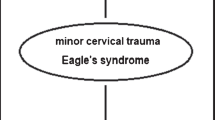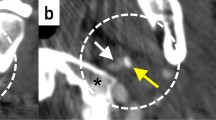Abstract
Styloid process length and styloid/hyoid bone proximity to the internal carotid artery (ICA) have been implicated in certain carotid pathologies (e.g. carotid artery dissection). Neck movement or trauma may contribute to some of these carotid pathologies. Styloid/hyoid bone to ICA distances have never been systematically analyzed in regard to head rotation and head flexion–extension. We studied axial slices on computed tomography angiograms of 103 nondissection patients showing > 1° head rotation. We measured the distance between ICA and the hyoid bone (HICA) and the closest point and the tip of the styloid bone (SCICA and STICA, respectively), the length of the styloid, and the angle of head rotation and head flexion–extension. STICA distances were significantly smaller on the right as compared to the left side in both the right and the left rotating patient groups (right STICA, 4.4 mm for the right rotating group and 6.4 mm for the left rotating group, p = 0.0091; left STICA, 5.1 mm for the right rotating group and 6.9 for the left rotating group, p = 0.034). No significant differences were observed for SCICA and HICA distances between right and left rotating groups, and head flexion–extension did not altered significantly SCICA, STICA, or HICA distances. Both right- and left-sided head rotation seems to be associated with decreased right-sided and increased the left-sided styloid tip to internal carotid artery distances. This has to be studied and confirmed in single patient analyses using more severe head rotation and flexion–extension angles.


Similar content being viewed by others
References
Abdelaziz OS, Ogilvy CS, Lev M (1998) Is there a potential role for hyoid bone compression in pathogenesis of carotid artery stenosis? Surg Neurol 51:650–653
Zuber M, Meder JF, Mas JL (1999) Carotid artery dissection due to elongated styloid process. Neurology 53:1886–1887
Kölbel T, Holst J, Lindh M et al (2008) Carotid artery entrapment by the hyoid bone. J Vasc Surg 48:1022–1024
Faivre A, Abdelfettah Z, Rodriguez S et al (2009) Neurological picture. Bilateral internal carotid arterydissection due to elongated styloid processes and shaking dancing. J Neurol Neurosurg Psychiatry 80:1154–1155
Colby CC, Del Gaudio JM (2011) Stylohyoid complex syndrome: a new diagnostic classification. Arch Otolaryngol Head Neck Surg 137:248–252
Hong JM, Kim TJ, Lee JS et al (2011) Repetitive internal carotid artery compression of the hyoid: a new mechanism of golfer’s stroke? J Neurol Neurosurg Psychiatry 82:233–234
Raser JM, Mullen MT, Kasner SE et al (2011) Cervical carotid artery dissection is associated with styloid process length. Neurology 77:2061–2066
Renard D, Rougier M, Aichoun I et al (2011) Hyoid bone-related focal carotid vasculopathy. J Neurol 258:1540–1541
Renard D, Freitag C (2012) Hyoid-related internal carotid artery dissection. J Neurol 259:2501–2502
Razak A, Short JL, Hussain SI (2014) Carotid artery dissection due to elongated styloid process: a self-stabbing phenomenon. J Neuroimaging 24:298–301
Renard D, Azakri S, Arquizan C et al (2013) Styloid and hyoid bone proximity is a risk factor for cervical carotid artery dissection. Stroke 44:2475–2479
Schneider CG, Kortmann H (2007) Pseudoaneurysm of the common carotid artery due to ongoing trauma from the hyoid bone. J Vasc Surg 45:186–187
Burulday V, Akgül MH, Bayar Muluk N et al (2017) The importance of medial-lateral styloid process angulation/coronal plane angle in symptomatic eagle syndrome. Clin Anat 30:487–491
Eraslan C, Ozer MA, Govsa F et al (2017) Relationship of stylohyoid chain and cervical internal carotid artery detected by 3D angiography. Surg Radiol Anat 39:897–904
Kent DT, Rath TJ, Snyderman C (2015) Conventional and 3-dimensional computerized tomography in Eagle’s syndrome, glossopharyngeal neuralgia, and asymptomatic controls. Otolaryngol Head Neck Surg 153:41–47
Muthusami P, Kesavadas C, Sylaja PN et al (2013) Implicating the long styloid process in cervical carotid artery dissection. Neuroradiology 55:861–867
Yilmaz MT, Akin D, Cicekcibasi AE et al (2015) Morphometric analysis of styloid process using multidetector computed tomography. J Craniofac Surg 26:e438–e443
Kim BJ, Yang E, Kim NY et al (2016) Vascular tortuosity may be associated with cervical artery dissection. Stroke 47:2548–2552
Author information
Authors and Affiliations
Corresponding author
Ethics declarations
Conflict of interest
The authors declare that they have no conflict of interest.
Research involving human participants and/or animals
This article does not contain any therapeutic study with human participants or animals performed by any of the authors.
Informed consent
Informed consent was obtained from all individual participants included in the study.
Rights and permissions
About this article
Cite this article
Renard, D., Tatu, L. Anatomical relationship between carotid artery and styloid and hyoid bones in patients showing unintended head rotation on CTA. Acta Neurol Belg 118, 597–602 (2018). https://doi.org/10.1007/s13760-018-1008-7
Received:
Accepted:
Published:
Issue Date:
DOI: https://doi.org/10.1007/s13760-018-1008-7




